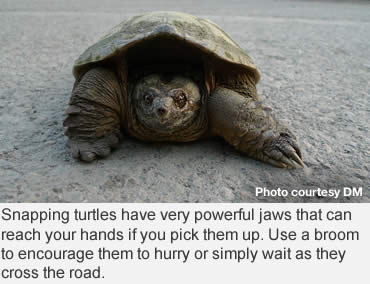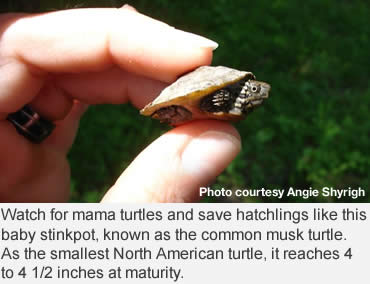Photo: If you help a turtle to cross a road, assist its journey by always moving it in the same direction it was heading.
It’s spring and turtles are on the move—slowly. Very slowly. From Massachusetts to Mississippi and across eastern, Midwestern and western states from May through July, turtles are active, seeking mates and nesting grounds.
Very often they’re spotted crossing roads, but too often turtles are the losers when moving vehicles are involved. That’s why conservation biologists everywhere asking folks to slow down and give turtles a brake and a chance to continue living.
Many turtle species live beyond 80 years, and some species need to reach the age of 35 to 40 years to successfully replace themselves in the population. That’s why it’s important to protect older adult turtles from cars.
 You may find turtles on roads, or you may notice them in your yard or an unexpected area as they move across the landscape searching for resources they need to survive.
You may find turtles on roads, or you may notice them in your yard or an unexpected area as they move across the landscape searching for resources they need to survive.
Humans may not understand where a traveling turtle is going, but they are creatures with a keen sense of direction and could be traveling to a wetland or open area to nest.
You may be able to help a turtle if you see one on the road.
But, do not risk getting hurt or causing harm to others by unsafely pulling off the road or dodging traffic. If you have a chance to safely move a turtle from the road, always move it in the direction it was heading and off the edge of the road.
Please, do not return the turtle to the side where it started from, or move it far away from where you found it. Turtles have specific territories, and moving them too far away can cause more harm than good.
For example, snapping turtles lay their eggs on land, so moving a pregnant female to water can impact her ability to lay her eggs.
While it may be tempting to take a wild turtle home, it’s important for the well-being of wildlife and people to keep wildlife wild.
 Handling turtles should be done with caution. Particular care should be taken with snapping turtles, which can inflict a serious bite.
Handling turtles should be done with caution. Particular care should be taken with snapping turtles, which can inflict a serious bite.
Snapping turtles are fast and have very powerful jaws that can sever fingers. They can also reach your hands if you pick them up by the sides of their shell.
If you recognize a snapping turtle, gently using a broom to encourage it to reach the side of the road it was headed toward. Never pick up a snapping turtle by its tail; this can injure its spine.
Other turtles can be picked up by their shells, gently using two hands, with your thumbs on the top of the turtle’s shell and other fingers supporting the underside of the shell. Handle the turtle only as long as needed to get it to safety.
Roadways bordered by wetlands on both sides are common crossing points for many turtles. Many state fish and wildlife agency biologists seek the public’s assistance by reporting where turtles are commonly seen crossing the road.
“Turtle nesting season provides us with a unique opportunity to see turtles moving on land, but it is an extremely vulnerable time for them,” said Melissa Doperalski, a wildlife biologist with the New Hampshire Fish and Game Department.
Resources—Maryland Department of Natural Resources, Wisconsin Department of Natural Resources, New Hampshire Department of Fish and Game, Arizona Game and Fish Department, Georgia Department of Natural Resources, Massachusetts Natural Heritage and Endangered Species Program.